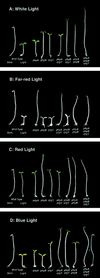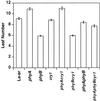Genetic interactions between phytochrome A, phytochrome B, and cryptochrome 1 during Arabidopsis development
- PMID: 9733523
- PMCID: PMC34865
- DOI: 10.1104/pp.118.1.27
Genetic interactions between phytochrome A, phytochrome B, and cryptochrome 1 during Arabidopsis development
Abstract
Single, double, and triple null combinations of Arabidopsis mutants lacking the photoreceptors phytochrome (phy) A (phyA-201), phyB (phyB-5), and cryptochrome (cry) 1 (hy4-2.23n) were examined for de-etiolation responses in high-fluence red, far-red, blue, and broad-spectrum white light. Cotyledon unhooking, unfolding, and expansion, hypocotyl growth, and the accumulation of chlorophylls and anthocyanin in 5-d-old seedlings were measured under each light condition and in the dark. phyA was the major photoreceptor/effector for most far-red-light responses, although phyB and cry1 modulated anthocyanin accumulation in a phyA-dependent manner. phyB was the major photoreceptor in red light, although cry1 acted as a phyA/phyB-dependent modulator of chlorophyll accumulation under these conditions. All three photoreceptors contributed to most blue light deetiolation responses, either redundantly or additively; however, phyB acted as a modulator of cotyledon expansion dependent on the presence of cry1. As reported previously, flowering time in long days was promoted by phyA and inhibited by phyB, with each suppressing the other's effect. In addition to the effector/modulator relationships described above, measurements of hypocotyls from blue-light-grown seedlings demonstrated phytochrome activity in blue light and cry1 activity in a phyAphyB mutant background.
Figures
References
-
- Ahmad M, Cashmore AR. HY4 gene of Arabidopsis thaliana encodes a protein with characteristics of a blue-light photoreceptor. Nature. 1993;366:162–166. - PubMed
-
- Ahmad M, Cashmore AR. Plant J. 1997;11:421–427. - PubMed
-
- Casal JJ, Boccalandro H. Co-action between phytochrome B and HY4 in Arabidopsis thaliana. Planta. 1995;197:213–218. - PubMed
-
- Desnos T, Orbovic V, Bellini C, Kronenberger J, Caboche M, Traas J, Höfte H. Procuste1 mutants identify two distinct genetic pathways controlling hypocotyl cell elongation, respectively in dark- and light-grown Arabidopsis seedlings. Development. 1996;122:683–693. - PubMed
-
- Drumm H, Mohr H. The mode of interaction between blue (UV) light photoreceptor and phytochrome in anthocyanin formation of Sorghum seedling. Photochem Photobiol. 1978;27:241–248.
Publication types
MeSH terms
Substances
Grants and funding
LinkOut - more resources
Full Text Sources
Other Literature Sources
Molecular Biology Databases
Research Materials



